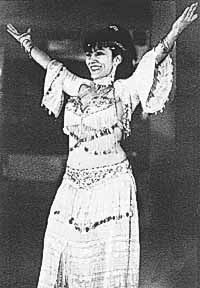Transformation Is Its Power
The Spiritual Connection
By Barbejoy A. Ponzio, Fri., Aug. 13, 1999
Long before Miss Ruth, early dance existed only as a ritual element. And it did not stand alone as a separate activity or profession. Rituals had specific purposes, such as fertility, hunting, healing. If the ritual dance was done right, the magic would happen: The land would be fertile. The hunt would be successful. The sick would be healed. Dance was the blessing and the prayer. Today there are some Middle Eastern dancers who also believe if the moves are done right, they will be blessed.
Pat Taylor, Southwest Texas State University instructor, dance historian, and Middle Eastern dance performer, asserts, "The women who are drawn to bellydancing are eccentrics. Every woman I know who is in this dance form is exceptional. For anyone who sticks with it more than six weeks, there is some deep hunger that this dance fills. For some, it is a chance to perform and they would kill to be onstage. For others, there is a spiritual life that this dance feeds. The great star Suhayrzeki believes that if she is on the stage and makes a movement perfectly, all will be good, she will be graced. So there is a spiritual core to many of the commercial Middle Eastern dance stars.
"American dancers tend more to believe that they're in touch with the Great Mother. The Seventies feminist revisionists like to define 'bellydancing' as the revival of the worship of the Great Mother. They are, through the dance, worshiping Her. They use the dance as a ritual, a spiritual awareness. If it serves a purpose, that is okay. But because I am a historian and classically trained, I hew my line to something more definite, something more grounded in the culture that created the form."
Z-Helene is one of those dancers who experiences a holy connection when she performs. She avows, "There is something very transcendent when a dancer can really connect with the music and audience. There is a transcendent quality akin to what happens in a religious ceremony. It doesn't always happen, because most times it is just pure entertainment, not-so-good stuff. [But] when the dancer is really good and can really communicate, there is a real deep connection to the life cycles and a connection to a higher being, a higher source of power -- the Goddess. She is this fertile, beautiful, compassionate, loving, sexy, and spiritual person. When it really does connect, it is sexy and religious. That is what I love about it. It is holy and sexy.
"I think we honor the feminine incredibly and the feminine aspect of spirituality -- the feminine as deity as opposed to just the masculine as deity. It is important that the feminine be honored, because when it was not honored as a spiritual being, as Her deity status declined, the status of women declined. As there was less Goddess worshiping, as it was being wiped out and Her temples were being destroyed, women were being more and more controlled. To me, it is so important that as women we see ourselves as divine, as embodying divine energy, because we have been so brainwashed into this father-son deal. It is destructive."
Honoring the Feminine -- Any Age, Body Size, Shape, or Form
America may be the land of the free, but it is enslaved by unrealistic notions of body image and age and is still wrestling with leftover Puritanical issues of sexuality. The Middle Eastern dancer transcends our culture's harsh standards of ideal beauty. Through her charismatic movements, she transcends her appearance and so hypnotizes the audience into a dream of enchanting, exquisite form. Middle Eastern dance offers new "ways of seeing" a dancer's body, and in turn, new ways for viewers to look at their own bodies.
For Vonda Totten, UT technical writer by day and bellydancer-teacher with Troupe Mirage by night, Middle Eastern dance has helped her to celebrate her body. "I love moving my hips," she says. "I have always had lower-body balance and good-sized hips. I love having a place where it is honored. I am not the thinnest person in the world. I have been told by my students, 'Oh, it is so nice to see someone who's built with hips like yours and can dance, that there is a place for you to go.' Okay, I'll take that as a compliment.
"I think as Western women we have a lot of hang-ups. We have a lot of stereotypes. The reason I like bellydance is that it makes me stare all of that right in the face. Performing publicly is about my own self-journey and my own self-image. Every time I perform, I have to realize that I am not happy with myself, but I have the power within myself to change. It forces you to learn and accept the beauty of yourself. For me, it has been more of a spiritual, personal journey. When I used to walk into a room, I would always try and hide. Now, my demeanor is more presence-oriented. I stand up straight. I use arm gestures. I have strength. I have power. Dance has given me a lot. I am lucky I found a form that I can do."
|
|
Bobbye Dee declares that no matter what age you are, the dance will change your attitude and you will blossom. It renews you. "A lot of people that take my classes for the first time are adults. They have already raised their families and they want to do something creative. They never got a chance to dance as a child. The oldest student I have right now is 67. She is in wonderful shape. The youngest I have is 17. I have a mother-and-daughter team in my troupe. Most of the women want to do it for fun and some really want to become professional dancers." Totten adds, "Most people who start dancing are between 25 and 35. At 30 years old, it may be the first time a woman performs -- costume, lights, and all." And Taylor remarks, "I think that bellydance does allow women to find literally a place in which to breathe, to be, to expand into a full presence. For middle-aged women in America, we simply disappear. It's eerie. Thank God I've got the dance!"
"The dance is also about being secure with your femininity," comments Taylor. "Being perfectly content with your body, no matter what your body size and type are. It is about self-love. This dance is about going to your core. An American bellydancer will come into the room with her veil and with the attitude of 'love me, love me, love me. Look how beautiful I am.' The American energy is going out, out, out. She is giving it away. A Middle Eastern dancer comes into the room with an attitude that says, 'You are so lucky I am here. You are here. You are paying. You want to see me, right?' As a Middle Eastern dancer, I bring the energy in. Whatever happens after that is between you and your god. That is what I do onstage. You are saying to your beloved, 'Oh my god, I missed you. You missed me. Let's go look at the moon together.' You are taking your deepest romantic emotion, sexual emotion, out in public and there is nothing wrong with it. We are entertainers. We are supposed to be beautiful to look at, pleasurable to look at. For all the talk about 'bellydancingÇ' going onstage in the theatre, the times I have seen it in the theatre, it has lost a great deal. It is an intimate dance form and it is meant to be integrated with normal life. There is a dancer, food, drink, friends."
A staunch devotee of the dance's Egyptian cultural authenticity, Taylor continues, "The dancer is a sensual pleasure like the other sensual pleasures of life. She is also dancing for the women who can't dance but love to watch the dancers. They aren't threatened by them. Because in a Muslim household, the woman is the queen of the home. While speaking to the Austin Bellydance Association, [UT Center for Middle Eastern Studies professor] Elizabeth Fernea said, 'Sexuality is revered in the Muslim world. Female sexuality is respected. In fact, the restrictions that are placed on women's behavior are there because women are considered to be so overpoweringly sexual that men cannot control themselves.' My friends who have lived in Saudi Arabia say, 'The women dance for each other. They dance not to seduce but to share.' The dance is not aimed at men. I don't dance for men. I don't know of many women who are serious about this dance form for whom it is seductive in that way [for men]. What they are dancing for is their own expression, their own sexuality. And it goes beyond sex. It is about all of the emotions."
When asked what it would take for Middle Eastern dance to be recognized as an art form alongside ballet, modern, and jazz dance, Z-Helene replies, "I would love it if the American public understood the depth, the beauty, and the spirituality this dance has. Instead changing the name of the dance, why don't we just shift what they think of it. They need to see some really good, powerful bellydancers, so that opinion will be shifted somewhat. I would really like to see that happen. It bothers me a little bit that we are considered a fringe dance. When I think we are the original dance. We pre-date any ballet or modern or jazz. I would like to see the image of bellydancing be brought to the level of where a lot of dancers are. There are some bad ballet dancers. There are some really bad modern dancers. I consider a modern dance bad when I can't keep my eyes open. I don't care how much technique they have. They definitely seem to train harder. There are some bellydancers that don't train as hard. It is a dance form that is a little forgiving of that, because so much of it is persona and energy. It is an energy that you communicate through your aura, whereas modern dance and ballet tend to work on the technical end almost exclusively. Gesturing of the emotion is not the real thing. It is just this big gesture. [Bellydance] allows something true and real to come across that can really touch people. In my bellydance fusion, I take the true essence of what bellydance is, thousands of years old, and I interpret it for 1999. I take into account the contemporary influences. When I do my soliloquies and talk about the cycles of life, I am really speaking about the here and now. I tie in the past with the present and the future, and give a meaning to peoples' lives as I have gotten it for myself."
In conclusion, Taylor sums up Middle Eastern dance's future: "If I grew up in the Middle Eastern culture, I would not be a professional dancer. In that culture, if you dance you can be a star, but you are an outcast. The people keeping this dance alive are us, because we are not part of that culture. When I asked Morocco, world-famous Oriental dancer and ethnologist, 'Now that Lebanon is at peace and Cairo is increasingly dominated by the fundamentalists, where is this dance form going to go? Do you think it is going to be revived in Beirut?' She said to me, 'It is here, baby. We are it. We are the dance form, because we have got the money, the mindset, the energy, and the ferocious American identity. We have industrialized, commercialized, and modified it. We are it!'"







